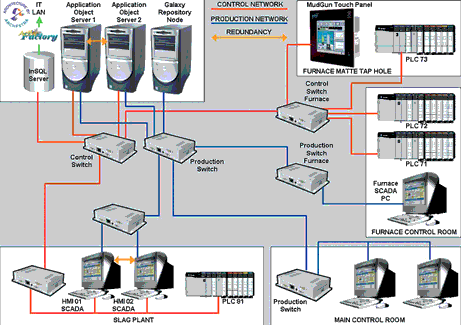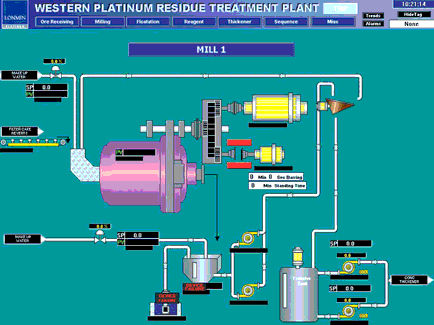
With platinum hovering at the $1300/ounce mark (April 2007), the production of the precious metal cannot tolerate inefficiencies or stoppages, and a crucial part of the process is smelting. Lonmin’s smelter in Marikana relies on Wonderware’s ArchestrA-based industrial automation solutions to keep the wheels turning.
Forget about striking while the iron is hot. Today's metal of choice is platinum. With industry specialists forecasting a rise to $1450/ounce and more by the end of 2007, any delays or stoppages in the production process have a direct and drastic effect on the bottom line of producers. That is why Lonmin chose a no-nonsense approach to the automation and control of its Marikana smelting plant.
Solution selection
The selected solution is Wonderware's ArchestrA industrial automation architecture with its attendant Industrial Application Server, IndustrialSQL Server (realtime historian), InTouch HMI (human-machine interface - scada) and ActiveFactory analysis and visualisation tool. To engineer the project, Lonmin selected system integrator Hiprom, which specialises in providing automation solutions to the mining and metals industries and which had successfully completed other projects for Lonmin since the company's inception in 1997.

"ArchestrA was chosen because it offers virtually unlimited growth and versatility while preserving the investment in existing assets," says Hiprom director Fritz Hiestermann. "But the most important reason is the ability to define, deploy and maintain standards in order to reduce engineering and maintenance costs. Since our first project for Lonmin, the setting of standards that work well and that can be re-used throughout all of the Lonmin operations have always been a top priority."
Implementation
The system consists of the following (see Figure 1):

* Four servers: the ArchestrA Galaxy Repository, two dual-redundant Application Object Servers (AOS) with load sharing and the IndustrialSQL server.
* One FactorySuite ArchestrA development station.
* Two dual-redundant Application Object Servers/HMI combinations at the slag plant. This was done in order that the plant would remain autonomous and continue operation should anything happen to the very long link connecting it to the rest of the system.
* Two InTouch HMIs in the central control room.
* One InTouch HMI in the furnace control room.
* One InTouch panel computer in the field at the furnace matte tap hole (matte is the product of the furnace and contains all the Platinum Group Metals).
* Four Allen Bradley ControlLogix PLCs.
The network is split physically into three layers in order to separate the IT LAN from the rest of the network:
* The control network connects the PLCs to the AOS servers.
* The production network (scada) connects the AOS servers to the HMI and IndustrialSQL Server.
* The IT LAN is connected to IndustrialSQL Server to enable ActiveFactory users to view production data.
Setting standards
Prior to the adoption of ArchestrA, the first standardisation effort at Lonmin consisted of establishing a good tag-naming convention and well-structured PLC programming standards. I/O and equipment lists were used to set up tag names but sometimes I/O lists were not available and the PLC addresses were used as a source for tag names. "This is not a good idea because there is no direct correlation between the scada tag-naming convention and that of the PLC," says Hiestermann. "So a change in one is not reflected in the other and confusion quickly sets in."
The standardisation initiative got a boost in 2000 at the Karee UG2 plant where the instrumentation staff was involved from the start. Consequently, by the time coding was started, complete I/O lists and good P&ID drawings were available. Early involvement of everyone concerned also meant that enough equipment was installed to obtain the data required for effective process management. "This eliminated the scenario of trying to calculate something based on non-existent data," says Hiestermann. "Another important contribution was made in adopting the Allen Bradley ControlLogix PLC which supported tag names rather than addresses. This meant that properly structured templates could be developed in the PLC and they looked the same as those in the scada system."
According to Hiestermann, standards excellence was achieved during the implementation and commissioning of the EPC and K4 concentrators at the end of 2001. "This was the same team that worked on the Karee plant and they already had proof of the benefits of standards. Once again, involving them early in the project resulted in very good PLC code, an excellent scada implementation and a well-structured and populated IndustrialSQL database. These same standards are still in use today on all Lonmin projects."
With standards already in place, when the time came to implement ArchestrA, the changeover was clearly defined and proved easy, but could more be done? And could existing procedures be improved? "We enlisted the help of Wonderware SA and they showed us how ArchestrA's functionality could improve and facilitate things that we previously thought were perfect. And we took things much further. It was no longer just a case of the instrumentation department versus the process department but more a case for collaboration," adds Hiestermann. "We started to look at the significance of the ISA-88 and ISA-95 standards and this made us appreciate the problems that process people were experiencing. Using ArchestrA's functionality we were able to build plant and process models which immediately got their attention and cooperation. Extending our vision beyond the scada domain allowed us to appeal to a broader audience to the benefit of the company. Things that make sense to a control engineer do not necessarily make sense to process staff or, for that matter, accountants. That is why it is often important to look at the bigger picture."
Benefits
* The ability to define, deploy and maintain standards is saving engineering time, cost and effort while providing a predictable and uniform development environment for engineers at all of Lonmin's facilities.
* Standardisation reduces risk on new projects because the tools that are used for implementation are known to work.
* Yet other benefits of standardisation include a uniform approach to support and maintenance throughout the group as well as helping with C&I governance and change management.
* ArchestrA facilitates the use of international standards (ie, ISA-88/95), which, in turn, improve the exchange of information between operational and business disciplines. This helps to synchronise the production processes with the company's business objectives.
* ArchestrA greatly simplifies the definition of complex plant objects by allowing the use and editing of existing templates to suit specific needs.
* The consolidation of all tags into a single database has all but eliminated errors and has simplified maintenance.
* With ArchestrA, the setup of the realtime IndustrialSQL Server historian comes at no cost.
* I/O words can be bit-picked which saves I/O points and provides more information at no additional cost and with no speed penalties.
Conclusion
By substituting engineering drudgery for ease and flexibility, ArchestrA is helping Lonmin focus on its business and strategic objectives rather than on the engineering complexities necessary to achieve them. While there is no doubt that standards place companies in better control of their production processes and help inter-discipline communication, what is often lacking is a practical mechanism to define, manage and propagate them. Lonmin has found such a mechanism in ArchestrA with the result that however many contractors and system integrators get involved with projects in the future, they will all have a common platform from which to operate and to develop collaborative solutions.
For more information contact Justin Tweedie, Wonderware Southern Africa, 0861 WONDER, [email protected], www.wonderware.co.za

© Technews Publishing (Pty) Ltd | All Rights Reserved